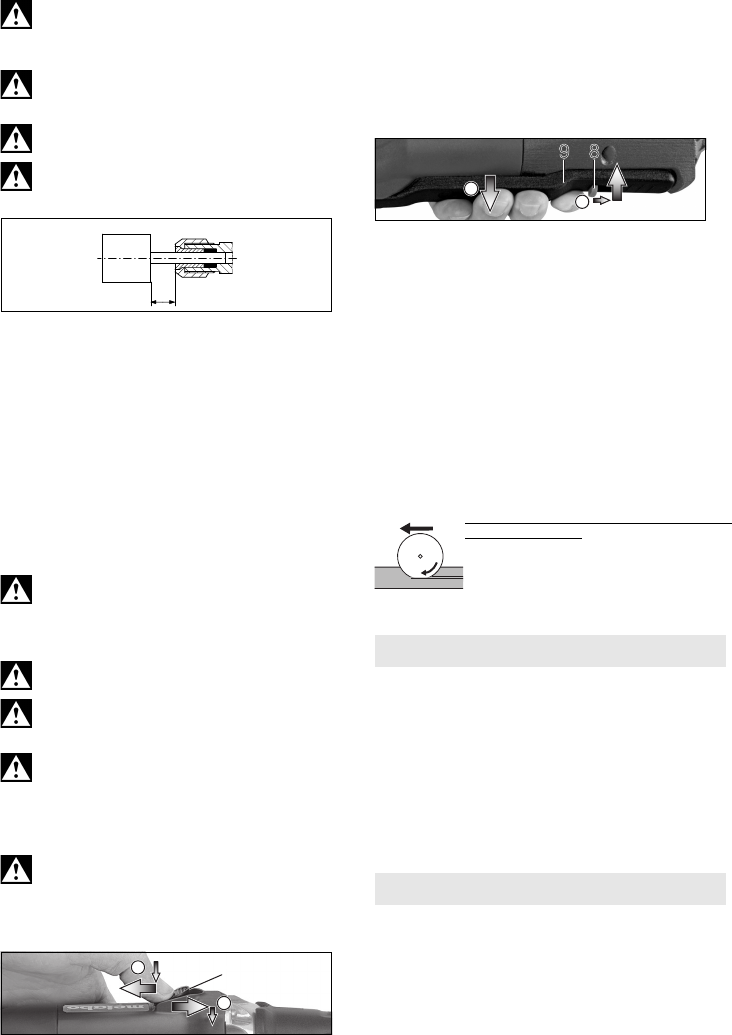
ENGLISH en
15
7.2 Fitting the tools
Before carrying out any modifications, remove
the battery pack from the machine and pull the
mains plug from the socket. The machine must be
switched off and the spindle at a standstill.
Only use tools that are suited to the no-load
speed of your machine. See the Technical
Specifications.
The tool's shank diameter must correspond
exactly to the collet bore of the collet chuck (1)!
For abrasive points, you may never exceed
the maximum open shank length specified by
the manufacturer l
0
.
The maximum permitted shaft length is the sum of l
0
and the maximum insertion depth L
max
(see
chapter13.)
Insert the tool (with the full length of the shank) in the
collet chuck (1).
Bring the spindle to a standstill. For the
GE 710 Compact, FME 737, use the 13-mm
spanner provided for this purpose. For the
GA 18 LTX, GPA 18 LTX, GA 18 LTX G,
GE 710 Plus, GEP 710 Plus, GE 950 G Plus,
GEP 950 G Plus, do this using the spindle lock
button (4).
Using the 17/19-mm spanner, tighten the collet
chuck nut (2).
If there is no tool inserted in the collet chuck,
you can tighten the collet chuck manually
rather than with the spanner.
7.3 Switching On and Off
Switch on first, then guide the accessory
towards the workpiece.
Avoid inadvertent starts: always switch the
tool off when the plug is removed from the
mains socket or if there has been a power cut.
In continuous operation, the machine
continues running if it is forced out of your
hands. You must therefore always hold the machine
with both hands using the handles provided (3), (5),
(7), assume a safe stance and concentrate while
working.
Avoid the machine swirling up or taking in dust
and chips. After switching off the machine,
only place it down when the motor has come to a
standstill.
Machines with slide switch:
Switching on: Push the slide switch (6) forward.
For continuous activation, now tilt downwards until
it engages.
Switching off: Press the rear end of the slide
switch (6) and release it.
Machines with slide switch
(with dead man function):
(Machines with the designation GEP..., GPA...)
Switching on: Slide the switch-on lock (8) in the
direction of the arrow and press the trigger (9).
Switching off: Release the trigger switch. (9)
7.4 Adjusting speed (mains powered
machines only)
The speed can be preset using the setting wheel
(10) and is infinitely variable. For a list of speeds,
see the table on page 3.
7.5 Working Directions
Grinding, sanding, polishing or using wire
brushes: Press gently and evenly on the machine
and move it from side to side over the surface.
Routing: Press gently and evenly on the machine.
Cutting-off operations:
Always work against the run of the disc
(see illustration). Otherwise there is
the danger of the machine kicking
back from the cut out of control. Guide
the machine evenly at a speed
suitable for the material being processed. Do not tilt,
apply excessive force or sway from side to side.
It is possible that particles deposit inside the power
tool during operation. This impairs the cooling of
the power tool. Conductive build-up can impair the
protective insulation of the power tool and cause
electrical hazards.
The power tool should be cleaned regularly, often
and thoroughly through all front and rear air vents
using a vacuum cleaner or by blowing in dry air.
Prior to this operation, separate the power tool from
the power source and wear protective glasses and
dust mask.
9.1 Mains powered machines:
- Overload protection: There is a MAJOR
reduction in load speed. The motor temperature
is too high! Allow the machine to run at idle speed
until it has cooled down.
- Overload protection: There is a SLIGHT
reduction in load speed. The machine is
overloaded. Reduce the load before continuing to
work.
l
o
0
I
6
8. Cleaning
9. Troubleshooting
0
I
9 8


















